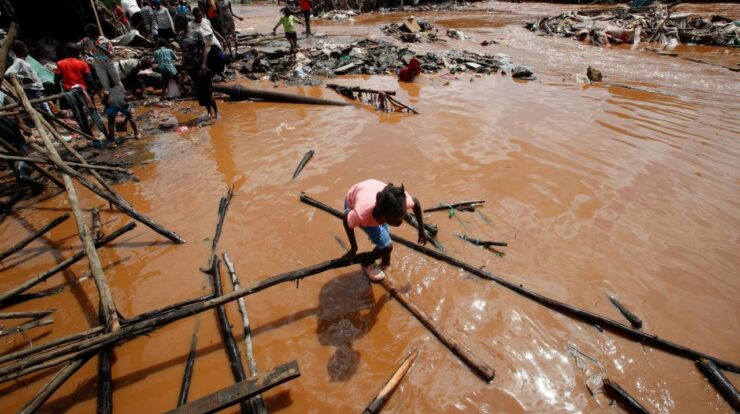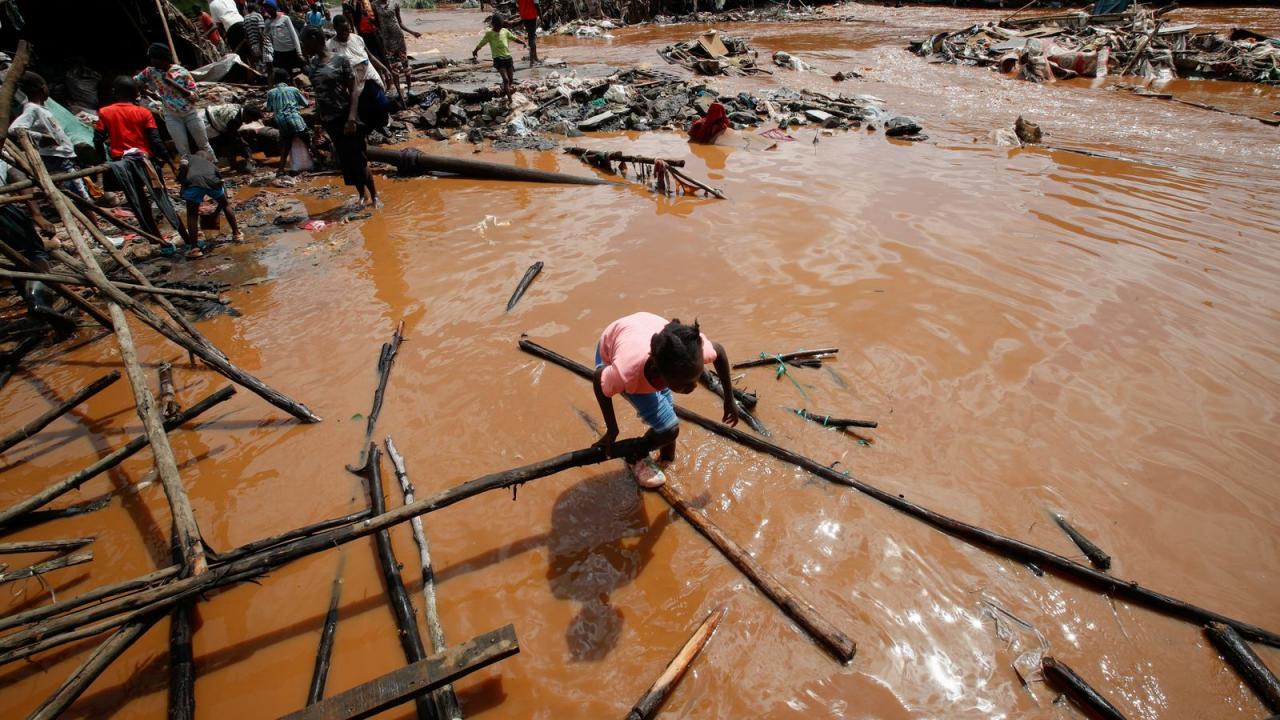
Kenya nairobi flooding – The relentless rains that have battered Kenya’s capital, Nairobi, have left a trail of destruction, displacing thousands and exposing the city’s vulnerability to extreme weather events.
From inundated streets to submerged buildings, the flooding has brought Nairobi to a standstill, disrupting transportation, severing communication networks, and threatening the well-being of its residents.
Impact on Infrastructure
The flooding in Nairobi has caused widespread damage to infrastructure, including roads, bridges, and buildings. The collapse of roads and bridges has disrupted transportation networks, making it difficult for people to travel and businesses to operate. Buildings have been damaged or destroyed, leaving many people homeless.
Economic Losses and Disruption
- The flooding has caused significant economic losses due to damage to infrastructure, disruption to transportation and communication networks, and loss of business revenue.
- The collapse of bridges has cut off access to major roads, leading to delays and increased transportation costs.
- Flooding has damaged communication networks, affecting businesses and individuals who rely on the internet and phone services.
Specific Infrastructure Affected
- Several bridges in Nairobi have collapsed, including the Mbagathi Bridge and the Haile Selassie Bridge.
- Major roads, such as the Thika Road and the Mombasa Road, have been flooded and damaged.
- Buildings in low-lying areas have been submerged in water, causing structural damage and loss of property.
Humanitarian Crisis

The flooding has displaced thousands of people from their homes, leaving them homeless and vulnerable. Many people have sought shelter in evacuation centers or with family and friends, while others are living in temporary shelters.
Challenges Faced by Displaced People
- Displaced people face challenges accessing food, water, and sanitation, as well as healthcare and other essential services.
- Children and the elderly are particularly vulnerable to the effects of displacement and may require additional support.
- The lack of shelter and access to basic necessities can lead to health problems and other issues.
Provision of Aid
- Government agencies, NGOs, and international organizations are providing shelter, food, and medical care to those affected by the flooding.
- Evacuation centers have been set up to provide temporary shelter for displaced people.
- Food and water distribution is ongoing, and medical teams are providing healthcare services to those in need.
Environmental Consequences
The flooding has had a significant impact on the environment, affecting water quality, ecosystems, and biodiversity. The contamination of water sources and the spread of waterborne diseases pose a serious threat to public health.
Water Quality and Contamination
- Flooding has contaminated water sources, including rivers, lakes, and wells, with sewage and other pollutants.
- The consumption of contaminated water can lead to waterborne diseases, such as cholera, typhoid, and dysentery.
- The flooding has also damaged water treatment facilities, further exacerbating the problem.
Impact on Ecosystems and Biodiversity, Kenya nairobi flooding
- Flooding has destroyed habitats for wildlife, leading to the loss of biodiversity.
- The flooding has also damaged agricultural land, affecting food production and livelihoods.
- The long-term impact of the flooding on the environment is still being assessed.
Government Response
The Kenyan government has taken steps to address the flooding, including providing emergency relief and implementing long-term recovery plans. The government has also coordinated with international organizations and foreign governments to provide assistance.
Emergency Relief Measures
- The government has deployed emergency services to rescue and evacuate people from flooded areas.
- Evacuation centers have been established to provide temporary shelter for displaced people.
- Food and water distribution is ongoing, and medical teams are providing healthcare services to those in need.
Long-Term Recovery Plans
- The government is working on long-term recovery plans to rebuild damaged infrastructure and support affected communities.
- These plans include repairing roads and bridges, providing housing for displaced people, and implementing measures to prevent future flooding.
- The government is also working with international organizations and foreign governments to secure funding and technical assistance for recovery efforts.
International Aid

International organizations and foreign governments have provided assistance to Kenya in response to the flooding. This assistance includes financial support, medical supplies, and technical expertise.
Types of Aid Provided
- International organizations, such as the United Nations and the Red Cross, have provided financial support, medical supplies, and personnel to assist with relief efforts.
- Foreign governments, such as the United States and the United Kingdom, have also provided financial support and technical expertise.
- The assistance provided has helped to support emergency relief efforts and long-term recovery plans.
Impact of International Aid
- International aid has played a significant role in supporting Kenya’s response to the flooding.
- The financial support has helped to fund emergency relief efforts and long-term recovery plans.
- The medical supplies and technical expertise have helped to improve healthcare services and support affected communities.
Community Resilience: Kenya Nairobi Flooding
Local communities in Nairobi have responded to the flooding with resilience and support for each other. Community organizations and volunteers have played a vital role in providing aid and assistance to those affected.
Role of Community Organizations
- Community organizations have mobilized to provide food, water, and shelter to displaced people.
- They have also provided psychosocial support and counseling to those affected by the flooding.
- Community organizations have worked closely with government agencies and NGOs to coordinate relief efforts.
Role of Volunteers
- Volunteers have played a crucial role in providing hands-on assistance to those affected by the flooding.
- They have helped to evacuate people from flooded areas, distribute food and water, and clean up damaged homes.
- Volunteers have also provided emotional support and companionship to those in need.
Climate Change Implications
The flooding in Nairobi has raised concerns about the potential role of climate change in exacerbating the impact of extreme weather events. Climate change is leading to increased rainfall and more frequent and intense storms.
Scientific Evidence
- Scientific evidence shows that climate change is contributing to increased rainfall and extreme weather events.
- The Intergovernmental Panel on Climate Change (IPCC) has warned that climate change will lead to more frequent and intense flooding in the future.
- The flooding in Nairobi is a reminder of the urgent need to address climate change and reduce greenhouse gas emissions.
Projections for the Future
- Climate change projections indicate that flooding is likely to become more frequent and severe in Nairobi in the future.
- The city is already vulnerable to flooding due to its low-lying location and poor drainage systems.
- The government and local communities need to prepare for the increased risk of flooding and take steps to mitigate its impact.
Final Wrap-Up
As the waters recede, the true extent of the damage becomes evident, leaving a lasting impact on Nairobi’s infrastructure, environment, and communities. The city faces the daunting task of rebuilding and recovering, while also addressing the underlying factors that have exacerbated the flooding.
Essential FAQs
What caused the flooding in Nairobi?
The flooding was caused by unusually heavy rainfall, which overwhelmed the city’s drainage systems and led to widespread inundation.
How many people have been affected by the floods?
Thousands of people have been displaced from their homes and are in need of shelter, food, and medical care.
What is the government doing to address the flooding?
The government has deployed emergency response teams, provided relief supplies, and is working to restore essential services.





